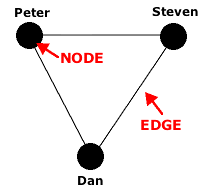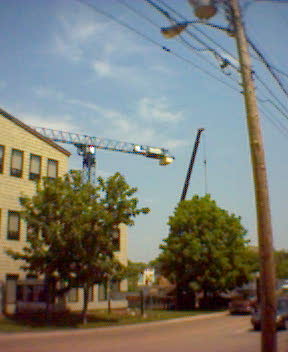In social network analysis we talk of nodes and edges. If we were to diagram the social network of a recent lunch at the Formosa Tea House, for example, it might look like this:

In this case the nodes are Peter, Steven and Dan and the edges are the “glue” that connect us.
It seems to me that we often tend to treat nodes as more important than edges when we’re building technology tools: we’re more interested in the nouns than the verbs.
I think this is especially true when it comes to web-based photo gallery systems: these are traditionally designed to be “photo-centric.” Which, on first blush, makes perfect sense; they are photo galleries after all.
Look at this photo of Dan or this photo of me.
The gallery systems these photos find themselves in (the silverorange Photo Gallery System and the open source Gallery system, respectively) treat the photo as the most important aspect of their operation. While both systems have a basic taxonomy or hierarchy into which the photos can be categorized, this is a secondary aspect of their operation. And in neither case does browsing the gallery by following the taxonomy offer much additional insight or depth to the experience.
These gallery systems, in other words, emphasize the node over the edge, and in doing so they assume that what we want to do when we use a web-based gallery is to look at photos, in much the same way we would using a physical photo album.
Over the past few weeks I’ve started to use Flickr as a gallery system, and I’m struck by the degree to which in that system edges are equal to or more important than nodes.
Yes Flickr is still a photo gallery, but with tags and groups and contacts and all of the other edge-centric functionality built into the application, in Flickr its the relationships between photos (and, to a lesser extent, the relationships between photographers) as much as the photos themselves that are important.
Part of my resistance to using Flickr to this point was that I was uncomfortable with the notion of “my stuff on somebody else’s servers.” After chatting about Flickr with Jacob Friis Larsen at reboot, though, I realized this stubbornness was getting in the way letting my photo-flow become part of a community photo-flow and, with that, a system where it’s not so much the photos that are interesting, but everything that surrounds them.
So this morning I took this photo of a crane. It’s a crappy photo. I took it with the crappy camera on my T610. But that doesn’t matter.
When the photo rides into the flow on the backs of my blog post and this Flickr tag and this Technorati tag it’s not really the photo that’s important. It’s the moment in time. It’s the what of the photo not the how. It’s the digital idea forest that builds up around the photo. The photo becomes part of the web, part of the tagged miscellany.
It used to be just a photo. A simple isolated node. Now it’s got edges. And that seems much, much more interesting.
I came into the office this morning and found, to my surprise, that in the night a crane had arisen over the city. Charlottetown doesn’t get many Big Construction Projects, so this is a big event.

I get a lot of ideas. Most of them get lost to time, confusion or distraction. I’ve decided that I should try documenting my ideas, or at least those that pass a threshold of 8 or 10 hours of musing, in the Rukapedia.
So here’s the first one: Call Anywhere.
Local afternoon show host Matt Rainnie is hosting a national radio show this summer called Lost & Found. Airs Saturdays at 1:00 p.m.
Air Canada has a policy that a flight isn’t considered “late” until it’s more than 15 minutes late.
As I flew to Copenhagen last week from Charlottetown, a trip that required 6 flights there and back, I thought a lot about that policy. And I realize that it says a lot about how Air Canada thinks of their service and their passengers.
To Air Canada, a delay of 15 minutes or less must feel “good enough.” Perhaps they even consider it a miracle to make all their systems run smoothly enough to guide a plane from gate to gate inside such a small window.
What they forget, though, is that to a traveler, 15 minutes is the equivalent of about 2 hours. Travel is stressful. There’s not only the “the plane might fall out of the sky” problem, but there’s the cramped space, the worry about the luggage, the stale air in the terminal and on the plane. When you’re waiting for a flight you’re worried about where you’re going to sit: will the seat recline, will there be enough room for your luggage, will your seat be right beside the toilet? And when the flight looks like it’s not going to be on time, you start to worry about the meetings you’re going to miss, the rental car they’re going to give to someone else, whether you’ll make your hotel on time.
All of this is amplified greatly when it’s a 7 or 8 hour flight you’re waiting for. In fact I’d hazard a guess that the most stressful part of flying, for many, is the wait at the gate.
So while Air Canada thinks to itself “hey, 15 minutes isn’t so bad — we don’t even need to tell the passengers about it,” the collected grief of their passengers, watching the minutes tick by, festers.
Rental car companies have a similar problem. I seldom get anything close to the car I reserve on rental company websites. I once reserved a Toyota Corolla from Alamo and they tried to give me a Chevy Astro. I settled for a Malibu.
It seems that rental companies think that if they can give you a vehicle with four wheels, they’ve done their job. They don’t seem to understand that this vehicle is going to be akin to a tiny rolling home for a bit of my life, and that it does matter what it looks like, that it doesn’t smell like smoke, that it uses fuel wisely, and so on. In the car rental world the cars are inventory, and so one car is, it seems, pretty much like any other.
I used to think that this sort of thinking, this sort of policy, was the result of intentional maliciousness on the part of companies, that they actually set out to be callous and unthinking. Or at the very least that their systems were simply broken.
But then this morning I stopped in at the local Rogers Wireless mobile phone dealer. I had a question about accessing the Internet with my phone and I thought they could help. I set my phone on the counter to demonstrate that I was an actual customer with a real phone.
And they picked my phone up and started to play with it. And then they passed it around the office to have others take a look. They looked at my phone — and this is easy to understand — as a simple piece of technology that needed fixing. They see a million phones a day, and this was just another one.
What they didn’t think about is that my phone is a piece of very personal technology to me. I have pictures of Catherine and Oliver on it. My email. My phone book. I’ve used that phone to talk to Catherine from across the ocean and to say goodnight to Oliver. I sat on a terrace in France and talked to my colleagues in America on that phone. I used it to find a hotel in Bourges and to give my Dad a call before leaving for Denmark.
Passing around my phone like a piece of broken inventory leaves all of that out of the equation. And it made me feel just like I feel with the car rental company thoughtlessly offers me a Chevy Astro or Air Canada runs a late flight and doesn’t tell me because in their world it’s not really late.
And putting all these together I realized that companies are systems, and customers, cars, flights, and phones necessarily become abstractions in a system as large as Air Canada or Hertz or Rogers.
Air Canada can’t feel bad about making me worried that I’ll miss an important meeting. Budget can’t worry about whether I get a Cavalier or an Accord. Rogers has millions of phones in millions of hands: their system can’t treat a phone like a treasured personal instrument because that would simply gum up the system.
So it’s not that companies are malicious, it’s not that their systems are broken, it’s that they operate on a scale that, of necessity, treats passengers the same as flights, cars, and phones: as objects to be handled, shuffled, repaired, flown, scheduled.
A Chevy Astro or an A-320 doesn’t have feelings, doesn’t get worked up about where it is or how it’s being treated, so why should a person?.
Perhaps this shouldn’t come as a revelation to me, but it does.
Beanz is now a Plaze, with WiFi presumably leaking over University Ave. from the Downtown Diner. I think this means that my life now has 100% wireless coverage.
Two “television shows on the Internet,” both about technology:
Interesting. ObIslandConnection: one of the hosts of command-N is Amber MacArthur.
MarinaGrill, aka Eddie’s Lunch, has WiFi coursing through it. So it’s now a place to eat and a Plaze to eat both. Is there any corner of my life that isn’t wireless-enabled now?
 I am
I am